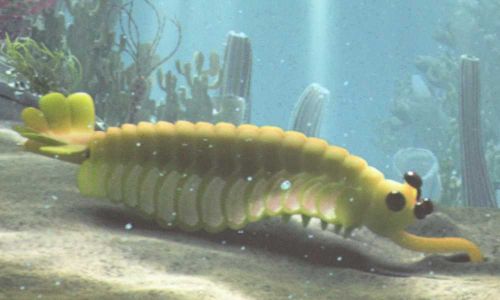 Life reconstruction of the specialised dinocaridid Opabinia regalis, shown here probing a worm burrow. Image from Opabinia (collection of images)
Life reconstruction of the specialised dinocaridid Opabinia regalis, shown here probing a worm burrow. Image from Opabinia (collection of images)| Dinocaridida | ||
| Ecdysozoa | AOpabinia |
| Classification | Ecdysozoa | Panarthropoda
└─► |
Anomalocarididae (1) | |
| Onychophora | Arthropoda |
|
Abbreviated Dendrogram
Panarthropoda
╘═Siberiidae
│
└─Dinocaridida
├─Kerygmachela
└─┬─Pambdelurion
└─┬─Opabinia
└─┬─Anomalocarididae
│ ├─Hurdia
│ └─┬─Anomalocaris
│ └─Laggania
└─┬─Schinderhannes
└─Arthropoda
|
Contents
Overview |
 Life reconstruction of the specialised dinocaridid Opabinia regalis, shown here probing a worm burrow. Image from Opabinia (collection of images) Life reconstruction of the specialised dinocaridid Opabinia regalis, shown here probing a worm burrow. Image from Opabinia (collection of images) |
Photograph and caption by Jstuby Wikipedia, , Public domain |
Opabinia regalis Walcott 1912
Horizon: Burgess Shale of British Columbia (Middle Cambrian)
Phylogeny: Dinocaridida : Kerygmachela + (Pambdelurion + ((Anomalocarididae + (Schinderhannes + (Parapeytoia + Arthropoda))) + * ))
Opabinia + higher panarthropods: trunk without annulation; (Edgecombe 2009 fig 3); Opabinia only: Loss of plate-like circumoral structure; posterior tagma composed of three paired tail flaps (Daley et al 2009 cladogram, supplement fig S3)
Comments: One of the most bizarre animals that ever lived, Opabinia has five eyes at the front of the head and a long, flexible proboscis ending in an array of grasping spines. The trunk comprises 15 segments, each bearing a pair of downward-directed lateral lobes, thought to have been used for propulsion, each overlain by a lamallate gill. Three pairs of upward-directed flaps form a tail fan, possibly served a stabilising or steering function during swimming.
The systematic position of Opabinia was for some time very unclear. It was originally interpretated as a branchiopod or a trilobitomorph. Whittington thought it might belong to the stem group leading to a annelid+arthropod clade. Gould naturally used it (along with the upside down Hallucinogenia) as an illustration of the bizarre nature of Cambrian life, considering it toally unrelated to any living phylum. As with most of Gould's problematica however, Opabinia soon turned out to be a stem form of extant animals. Collins placed it in the Dinocaridida, as did Budd, who placed it between lobopods and arthropods. Recent cladistic analyses support this, and locate Opabinia as a Dinocaridid immediately basal to the anomalocaridida (Daley et al 2009; Liu et al 2011.). As such, Opabinia is actually a highly specialised anomalocaridid, rather than a unique member of its own phylum.
Opabinial is thought to have lived primarily in the soft sediment of the seabed, but to have been a predator capable of active swimming. The proboscis was presumably used to capture and handle prey, and may possibly have served to extract burrowing organisms from their burrows. (After Briggs et al. 1994, p. 210.) Chris Clowes, MAK120511
Links: Opabinia regalis by Sam Gon III; Wikipedia
page MAK120503; Creative Commons Attribution